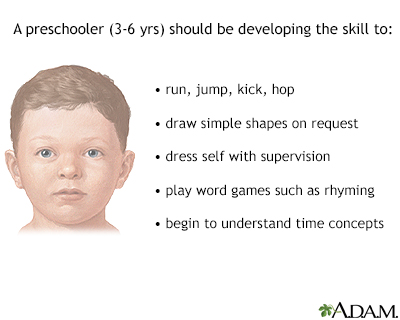Pregnancy SmartSiteTM
Developmental milestones record - 3 to 6 years; Well child - 3 to 6 years DefinitionThe normal social and physical development of children ages 3 to 6 years old includes many milestones. InformationAll children develop a little differently. If you are concerned about your child's development, talk to your child's health care provider. PHYSICAL DEVELOPMENT The typical 3- to 6-year-old:
Gross motor development in the 3- to 6-year-old should include:
Fine motor development milestones at about age 3 should include:
Fine motor development milestones at about age 4 should include:
Fine motor development milestones at about age 5 should include:
LANGUAGE DEVELOPMENT The 3-year-old uses:
The 4-year-old begins to:
The 5-year-old:
Stuttering may occur in the normal language development of toddlers ages 3 to 4 years. It occurs because ideas come to mind faster than the child is able to express them, especially if the child is stressed or excited. When the child is speaking, give your full, prompt attention. Do not comment on the stuttering. Consider having the child evaluated by a speech pathologist if:
BEHAVIOR The preschooler learns the social skills needed to play and work with other children. As time passes, the child is better able to cooperate with a larger number of peers. Although 4- to 5-year-olds may be able to start playing games that have rules, the rules are likely to change, often at the whim of the dominant child. It is common in a small group of preschoolers to see a dominant child emerge who tends to boss around the other children without much resistance from them. It is normal for preschoolers to test their physical, behavioral, and emotional limits. Having a safe, structured environment in which to explore and face new challenges is important. However, preschoolers need well-defined limits. The child should display initiative, curiosity, the desire to explore, and enjoyment without feeling guilty or inhibited. Early morality develops as children want to please their parents and others of importance. This is commonly known as the "good boy" or "good girl" stage. Elaborate storytelling may progress into lying. If this is not addressed during the preschool years, this behavior may continue into the adult years. Mouthing off or backtalk is most often a way for preschoolers to get attention and a reaction from an adult. SAFETY Safety is very important for preschoolers.
PARENTING TIPS
ReferencesAmerican Academy of Pediatrics website. 2022 Recommendations for preventive pediatric health care. Pediatrics. 2022;150(1):e2022058044. PMID: 35921638 pubmed.ncbi.nlm.nih.gov/35921638/. Carter RG, Feigelman S. The preschool years. In: Kliegman RM, St. Geme JW, Blum NJ, Shah SS, Tasker RC, Wilson KM, eds. Nelson Textbook of Pediatrics. 21st ed. Philadelphia, PA: Elsevier; 2020:chap 24. Marcdante KJ, Kliegman RM, Schuh AM. Normal development. In: Marcdante KJ, Kliegman RM, Schuh AM, eds. Nelson Essentials of Pediatrics. 9th ed. Philadelphia, PA: Elsevier; 2023:chap 7. | |
| |
Review Date: 10/31/2022 Reviewed By: Neil K. Kaneshiro, MD, MHA, Clinical Professor of Pediatrics, University of Washington School of Medicine, Seattle, WA. Also reviewed by David C. Dugdale, MD, Medical Director, Brenda Conaway, Editorial Director, and the A.D.A.M. Editorial team. The information provided herein should not be used during any medical emergency or for the diagnosis or treatment of any medical condition. A licensed medical professional should be consulted for diagnosis and treatment of any and all medical conditions. Links to other sites are provided for information only -- they do not constitute endorsements of those other sites. No warranty of any kind, either expressed or implied, is made as to the accuracy, reliability, timeliness, or correctness of any translations made by a third-party service of the information provided herein into any other language. © 1997- A.D.A.M., a business unit of Ebix, Inc. Any duplication or distribution of the information contained herein is strictly prohibited. | |

 Preschooler develo...
Preschooler develo...
